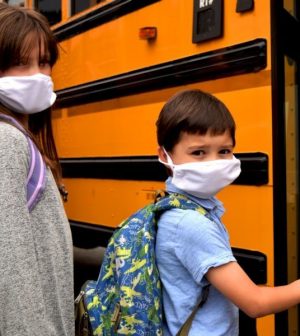- Navigating Your Midlife Crisis: Embracing New Possibilities
- City Raccoons Showing Signs of Domestication
- Mapping the Exposome: Science Broadens Focus to Environmental Disease Triggers
- One Week Less on Social Media Linked to Better Mental Health
- Your Brain Changes in Stages as You Age, Study Finds
- Some Suicide Victims Show No Typical Warning Signs, Study Finds
- ByHeart Formula Faces Lawsuits After Babies Sickened With Botulism
- Switch to Vegan Diet Could Cut Your Greenhouse Gas Emissions in Half
- Regular Bedtime Does Wonders for Blood Pressure
- Dining Alone Could Mean Worse Nutrition for Seniors
Pediatricians’ Group Says School Is Priority, With Proper Safety Measures

A prominent U.S. doctors’ group reaffirmed its recommendation this week that having kids physically in school should be the goal, while also outlining safety protocols needed to allow schools to be open.
In its COVID-19 guidance for safe schools, the American Academy of Pediatrics listed measures communities need to address. These include controlling the spread of COVID-19 in the community, protecting staff and students in schools and coordinating closely with local and state health experts.
“New information tells us that opening schools does not significantly increase community transmission of the virus. However, it is critical for schools to closely follow guidance provided by public health officials,” said Dr. Lee Beers, new president of the AAP.
“Children absolutely need to return to in-school learning for their healthy development and well-being, and so safety in schools and in the community must be a priority,” Beers said in an academy news release. She added that some children are really suffering without the support of in-person classroom experiences or adequate technology at home.
“We need governments at the state and federal levels to prioritize funding the needed safety accommodations, such as improving ventilation systems and providing personal protective equipment for teachers and staff,” Beers noted.
School transmission mirrors but doesn’t drive community spread, the AAP said. The group strongly recommended cloth face coverings for adults and students over age 2 plus physically distancing; adequate and timely COVID testing resources, and letting science and data guide decisions.
The current widespread circulation of the virus will require school officials to review local data and the latest evidence on transmission to determine the feasibility of in-person learning, the statement said.
School policies should be appropriate for children’s and teenagers’ developmental stages while also addressing teacher and staff safety, as well as behavioral and mental health needs, the group said. Special considerations should account for those who are medically fragile or complex, have developmental challenges, or have disabilities.
The group also weighed in on COVID-19 vaccination. Schools should collaborate with public health officials to ensure that staff have access to a vaccine, and pediatricians should promote the COVID-19 vaccine when it becomes available to young people.
Younger children appear to be less likely to spread the virus in a class or childcare setting, and they generally show milder or moderate illness, according to the AAP. This suggests in-person instruction for primary and elementary grades is appropriate with proper safety accommodations that are detailed in guidance provided by AAP and the U.S. Centers for Disease Control and Prevention, the group said.
“While the new vaccines offer hope for a return to a ‘new normal,’ schools must continue to take a multi-layered approach to protect students and staff,” Beers said. “Many are already taking precautions, and it is important to not let down our guard to protect ourselves and others.”
Federal, state and local funding should be provided for safety strategies for all schools, as well as funding to support virtual learning in under-resourced schools, the AAP said. The CDC estimates costs for safety strategies are between $55 and $442 per student, depending on the strategy.
“No single action or plan will eliminate the risk of virus spread at a school, but we have seen how face masks, physical distancing and other measures when combined can significantly lessen the risks,” Beers said. “By working together, we can get through this pandemic, as we must. Our kids are counting on us.”
More information
The Brookings Institute talks about how COVID-19 is affecting student learning.
SOURCE: American Academy of Pediatrics, news release, Jan. 5, 2021
Source: HealthDay
Copyright © 2025 HealthDay. All rights reserved.










